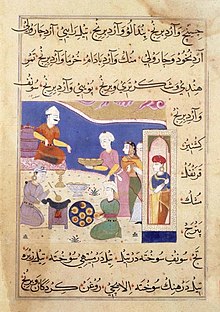Sambusuch
ferculum
Sambusuch[2] (conversio vocabuli Arabici سمبوسة sanbūsaq), linguis vernacularibus pluribus samosa, est ferculum generis pastellorum seu raviolorum. Primum praeceptum nobis cognitum e Bagdato saeculo X provenit. Saeculis insequentibus haec cuppedia occidenti versus ad Marocum, orienti versus ad Sinas imperium suum extendit; hodie autem "samosa" potius in India et in gastronomia Indica peregrina celebratur.






Notae
recensere- ↑ Titley (2004) pl. 23; Robert Skelton, "The Ni'mat nama: A Landmark in Malwa Painting" in Marg vol. 11 no. 3 (1959) pp. 44–48
- ↑ Iamboninus
Bibliographia
recensere- Etymologia et historica
- Anna Martellotti, Il Liber de ferculis di Giambonino da Cremona (Fasano: Schena, 2001) pp. 87, 101, 218-219, 290, 320-321
- Anna Martellotti, "Quinquenelli zoè rafioli" om Annali della Facoltà die Lingue e Letterature Straniere dell' Università di Bari ser. III vol. 15 (2001) pp. 351-372
- Sa’adia Reza, "Food’s Holy Triangle" in Dawn (19 Ianuarii 2015)
- Praecepta
- saec. X : Ibn Sayyār al-Warrāq, Kitāb al-ṭabīḫ (Kaj Öhrnberg, Sahban Mroueh, edd., Ibn Sayyār al-Warrāq: Kitāb al-ṭabīkh [Helsingiae: Finnish Oriental Society, 1987]; Nawal Nasrallah, interpr., Annals of the Caliphs' Kitchens: Ibn Sayyār al-Warrāq's Tenth-Century Baghdadi Cookbook [Lugduni Batavorum: Brill, 2007] cap. 36, pp. 190-192 (Paginae selectae apud Google Books))
- saec. XIII : Wuṣla ilā al-ḥabīb (Maxime Rodinson, Studies in Arabic Manuscripts in Maxime Rodinson, A. J. Arberry, Charles Perry, Medieval Arab Cookery [Totnes: Prospect Books, 2001] pp. 131-148) passim, vide indicem ("sanbūsak")
- saec. XIII : Kitāb al-ṭabīḫ fī'l-Maǧrīb wa'l-Andalūs (A. Huici Miranda, ed., La cocina Hispano-Magrebi en la España almohade [Matriti, 1965] f. 68v; Charles Perry, interpr., An Anonymous Andalusian Cookbook of the 13th Century Textus) ("sanbûsak")
- saec. XIII/XIV : Kitāb waṣf al-ʿaṭima al-muʿtada (Charles Perry, "The Description of Familiar Foods" in Maxime Rodinson, A. J. Arberry, Charles Perry, Medieval Arab Cookery [Totnes: Prospect Books, 2001]) p. 382 et alibi, vide indicem ("sanbūsaq")
- saec. XIII exeunte : Iamboninus Cremonensis, Liber de ferculis et condimentis no. 55 (Anna Martellotti, Il Liber de ferculis di Giambonino da Cremona [Fasano: Schena, 2001] pp. 218-219)
- saec. XIV : Kanz al-fawāʾid fī tanwīʿ al-mawāʾid (Manuela Marin, David Waines, edd. [Stutgardiae: Steiner, 1993]; Nawal Nasrallah, interpr., Treasure Trove of Benefits and Variety at the Table [Lugduni Batavorum: Brill, 2018] pp. 142-143, 149)
- 1330 : Hu Si-hui, Principia propria ad mensam Imperatoris (Paul D. Buell, Eugene N. Anderson, edd. et interprr., A Soup for the Qan: Chinese dietary medicine of the Mongol era as seen in Hu Szu-hui's Yin-shan cheng-yao [Londinii: Kegan Paul, 2000] no. 10, p. 282)
- c. 1500 : Nimmatnama-i-Nasiruddin-Shahi(en) (Norah M. Titley, ed. et interpr., The Ni'matnama Manuscript of the Sultans of Mandu: The Sultan's Book of Delights [Londinii: Routledge, 2004] pp. 3-4, 19, 76-77, 90, 107)
- c. 1590 : Abū al-Faḍl al-Mubārak, Āīn-i-Akbarī (H. Blochmann, H. S. Jarrett, interprr., The Aín i Akbari by Abul Fazl Allámi [Calcuttae: Asiatic Society, 1873-1894] vol. 1 p. 60)
- 1911 : Robert H. Christie, Banquets of the Nations: eighty-six dinners characteristic and typical each of its own country (Edinburgi: Gray) p. 335 ("Parsee: Samosa")
- 1980 : Meera Taneja, Indian Regional Cookery (Londinii: Mills and Boon) pp. 18-19 ("aaloo samosa, pastries filled with spicy potato")
- Aliae encyclopaediae
- "Samosa" in Alan Davidson, The Oxford Companion to Food (Oxonii: Oxford University Press, 1999. ISBN 0-19-211579-0) p. 690; Tom Jaine, ed., 2a ed. 2006; 3a ed. 2014